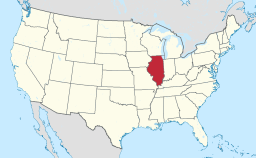Lemont, Illinois
| Lemont, Illinois | |
| Village | |
|
The clock in the center of downtown Lemont
|
|
| Official name: Village of Lemont | |
| Name origin: From French for "The Mount" | |
| Motto: Village of Faith | |
| Country | United States |
|---|---|
| State | Illinois |
| County | Cook, Will, and DuPage |
| Township | Lemont |
| River | Des Plaines River |
| Coordinates | 41°40′08″N 87°59′20″W / 41.668784°N 87.988845°WCoordinates: 41°40′08″N 87°59′20″W / 41.668784°N 87.988845°W |
| Area | 8.35 sq mi (22 km2) |
| - land | 7.97 sq mi (21 km2) |
| - water | 0.38 sq mi (1 km2) |
| Population | 16,000 (2010) |
| Settled | 1836 |
| Incorporated | June 9, 1873 |
| Mayor | Brian Reaves (R) |
| Timezone | CST (UTC-6) |
| - summer (DST) | CDT (UTC-5) |
| Postal code | 60439, 60490 |
| Area code | 630 |
|
Location in Cook County and the state of Illinois.
|
|
|
Location of Illinois in the United States
|
|
|
Website: lemont |
|
Lemont is a village located in Cook, DuPage, and Will counties in the U.S. state of Illinois, and is a suburb of Chicago. The population was 16,000 as of the 2010 census. Lemont has a substantial immigrant population. Lemont is home to the CITGO Refinery, Argonne National Laboratory and other heavy industrial sites.
Lemont was originally known as Keepataw (after a Potawatomi chief) and a post office was established in 1840 as Keepatau. After that, it was named Athens and then Palmyra. The name Lemont (literally, 'the mountain' in French) was chosen in 1850 at the suggestion of Lemuel Brown, the postmaster and justice of the peace, or perhaps by his brother Nathaniel Brown.
Even before white settlers came to Lemont, Native Americans traveled the Des Plaines River in birch bark canoes on trading trips between the Mississippi River and Lake Michigan. The native Potawatomi lived off the land in this area, directly using natural resources for food, shelter, clothing and medicine. In the 18th century, French voyageurs traveled down the Des Plaines River, trading Native Americans metal, beads and cloth for animal furs and changing the Native American lifestyle forever.
Established in 1836, the village of Lemont stands as one of the oldest American communities in northeastern Illinois. It is historically significant for its role in transforming the northern region of the state from a sparsely settled frontier to a commercial, agricultural, and industrial region that supplied Chicago and areas beyond with commodities. Lemont is also unique in boasting an authentic historic district that remains intact and has been continually used since the 19th century.
Both Lemont's history and architectural uniqueness connect to the Illinois and Michigan Canal (I&M Canal). Construction of the I&M Canal began in 1837 and stands as one of the last major canal undertakings in the United States (the Hennepin Canal opened in 1907). When it was completed in 1848, it provided a continuous waterway stretching from New York (through the Erie Canal, Lake Erie, Lake Huron and Lake Michigan to Chicago, then through the I&M Canal for 97 miles (156 km) entering the Illinois River at LaSalle, Illinois, to the Mississippi River, to New Orleans) to the Gulf of Mexico.
...
Wikipedia



